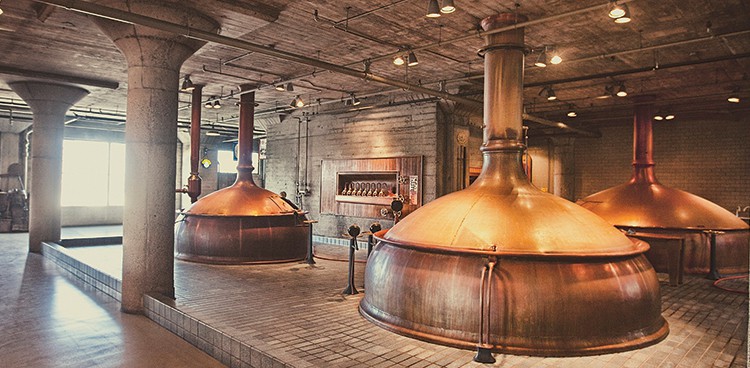
When it comes to beer, America has long been considered a copycat. The thought isn’t with-out merit: Bitter India pale ales, chocolaty stouts, and brisk pilsners were all conceived across the churning Atlantic. There are, however, two beer styles native to the United States. The first is cream ale, a brew fermented at cooler temperatures to increase crispness and curtail fruitiness (Genesee Cream Ale is the lasting example). The second quaff is the California common, also known as steam beer, invented to sate dehydrated miners.
In the mid-1800s the gold rush brought wagonloads of men west to sift for fortunes in streambeds. It was sweaty, backbreaking labor that worked up a mighty thirst. Enter enterprising brewers, who came to California toting trendy lager yeasts, most of which require cool temperatures for proper fermentation. Lacking ice and mechanical refrigeration, the entrepreneurs had to engage in trial and error to find the perfect strain.
Once brewers landed on yeast that fermented well at toastier temps, they pumped the warm wort—the sugary broth created by steeping grains in hot water—into shallow rooftop bins, where Pacific winds cooled the liquid. The thirst-quenching end product was a well-hopped, malt-forward amber beer with energetic carbonation. Whether due to the vapor rising off the wort during cooling or because kegs of the fizzy suds sprayed when tapped, the lager came to be known as steam beer.
The style bubbled through the 19th century and percolated past Prohibition, but by 1965 steam beer was sputtering. Along came appliance magnate Fritz Maytag—yes, of the washing machine brand and Maytag Dairy Farms—who bought San Francisco’s struggling Anchor Brewing and tweaked its steam beer recipe. By 1971 Maytag was bottling the reformulation, and Anchor Steam became the style’s savior and standard-bearer.
Chances are you won’t find another bottle labeled “steam beer” on your store’s shelves because Anchor trademarked the term. Instead, the medium-bodied, auburn-toned American original goes by “California common,” and there are examples from across the country: Maine’s Baxter Brewing Co. Tarnation and Iowa’s Toppling Goliath Brewing Company Dorothy’s New World Lager are classic interpretations, while New Hampshire’s Smuttynose Brewing Company elevates the hop profile in its East Coast Common and Virginia’s Ardent Craft Ales turns out the toasty Virginia Common.
Everywhere you look, the steam is rising.
Pairing Notes
Look to California common’s malty core when choosing accompaniments. Go complementary with moderately sweet cow’s milk cheeses such as Asiago—try nutty, creamy Sartori Asiago or Parish Hill Vermont Herdsman, which has a sublime caramel streak. Or choose Golden State native pepper Jack—the beer’s agreeable sugariness goes toe to toe with heat while its carbonation washes the rich fat away.
Four to Pour

Anchor Brewing Company Anchor Steam Beer
Fifty-plus years after Fritz Maytag saved steam beer, this American icon is still in tune with modern tastes. It smells fruity and earthy, its flavor evocative of biscuits and toffee.
Steamworks Brewing Co. Steam Engine Lager
Originally called Steam Engine Steam (trademark infringement forced the name tweak), this coppery Colorado lager has a caramel spine and a dry, crisp conclusion that counteracts the upfront sweetness.

Baxter Brewing Co. Tarnation Maine Lager
The can-mad Maine brewery’s take on tradition employs style-appropriate San Francisco yeast to create a rich, bready crowd-pleaser best stocked by the case.
Smuttynose Brewing Company East Coast Common
The New Hampshire brewery elevates the ABV of its common to an IPA-worthy 7.4 percent—aromas of tropical Citra and lemony Sorachi Ace hops abound.
Feature Photo Courtesy of Anchor Steam




